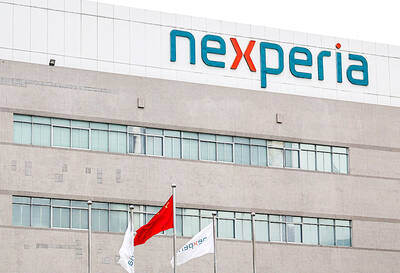Core Pacific Development Corp (鼎越開發) on Monday launched a pre-sale mixed-use project in downtown Taipei valued at more than NT$2 million (US$64,948) per ping (3.3m2), unfazed by an economic slowdown.
The company, an affiliate of Core Pacific Group (威京總部集團), whose business interests include China Petrochemical Development Corp (中石化) and BES Engineering Corp (中華工程), said its pricing strategy is reasonable and profitable for buyers, as there is robust demand for upscale office space in central locations, but limited supply.
The planned Core Pacific Plaza (京華廣場) in Songshan District (松山) is to feature four office buildings with 19 floors above ground and seven below, Core Pacific Group executive deputy general manager Max Chang (張嘉文) said.

Photo courtesy of Core Pacific Development Corp
The company intends to sell two buildings and keep another two for rent, allowing it to tap the property management business, Chang said.
Monthly office rents at Taipei Nan Shan Plaza (台北南山廣場) in the neighboring Xinyi District (信義) have reached NT$5,252 per ping and might climb higher, Chang said.
Core Pacific Plaza would prove equally competitive, as it is designed by Taipei 101’s architect, and would use the newest construction technologies to boost energy efficiency and meet sustainability requirements, he said.
The company’s asking prices might sound expensive today, but could become lower than others, due to its environmental, social and governance (ESG) compliance, as most existing office buildings do not meet ESG standards, Chang said.

JITTERS: Nexperia has a 20 percent market share for chips powering simpler features such as window controls, and changing supply chains could take years European carmakers are looking into ways to scratch components made with parts from China, spooked by deepening geopolitical spats playing out through chipmaker Nexperia BV and Beijing’s export controls on rare earths. To protect operations from trade ructions, several automakers are pushing major suppliers to find permanent alternatives to Chinese semiconductors, people familiar with the matter said. The industry is considering broader changes to its supply chain to adapt to shifting geopolitics, Europe’s main suppliers lobby CLEPA head Matthias Zink said. “We had some indications already — questions like: ‘How can you supply me without this dependency on China?’” Zink, who also

The number of Taiwanese working in the US rose to a record high of 137,000 last year, driven largely by Taiwan Semiconductor Manufacturing Co’s (TSMC, 台積電) rapid overseas expansion, according to government data released yesterday. A total of 666,000 Taiwanese nationals were employed abroad last year, an increase of 45,000 from 2023 and the highest level since the COVID-19 pandemic, data from the Directorate-General of Budget, Accounting and Statistics (DGBAS) showed. Overseas employment had steadily increased between 2009 and 2019, peaking at 739,000, before plunging to 319,000 in 2021 amid US-China trade tensions, global supply chain shifts, reshoring by Taiwanese companies and

Taiwan Semiconductor Manufacturing Co (TSMC, 台積電) received about NT$147 billion (US$4.71 billion) in subsidies from the US, Japanese, German and Chinese governments over the past two years for its global expansion. Financial data compiled by the world’s largest contract chipmaker showed the company secured NT$4.77 billion in subsidies from the governments in the third quarter, bringing the total for the first three quarters of the year to about NT$71.9 billion. Along with the NT$75.16 billion in financial aid TSMC received last year, the chipmaker obtained NT$147 billion in subsidies in almost two years, the data showed. The subsidies received by its subsidiaries —

At least US$50 million for the freedom of an Emirati sheikh: That is the king’s ransom paid two weeks ago to militants linked to al-Qaeda who are pushing to topple the Malian government and impose Islamic law. Alongside a crippling fuel blockade, the Group for the Support of Islam and Muslims (JNIM) has made kidnapping wealthy foreigners for a ransom a pillar of its strategy of “economic jihad.” Its goal: Oust the junta, which has struggled to contain Mali’s decade-long insurgency since taking power following back-to-back coups in 2020 and 2021, by scaring away investors and paralyzing the west African country’s economy.